
Genfit goes to China with a deal worth up to $228M for NASH drug
Fresh off the high of its Nasdaq IPO debut, and the low of comparisons to Cymabay — whose NASH drug recently stumbled — Genfit on Monday unveiled an up to $228 million deal with transpacific biotech Terns Pharmaceuticals to develop its flagship experimental liver drug — elafibranor — in Greater China.
The deal comes weeks after Genfit $GNFT issued a fiery defense of its dual PPAR agonist elafibranor, when competitor Cymabay’s PPARδ agonist, seladelpar, fizzled in a snapshot of data from an ongoing mid-stage trial. The main goal at the end of 12 weeks was for seladelpar to induce a statistically significant improvement in liver fat content, but data showed that patients on the placebo actually performed better.
Unlock this article instantly by becoming a free subscriber.
You’ll get access to free articles each month, plus you can customize what newsletters get delivered to your inbox each week, including breaking news.